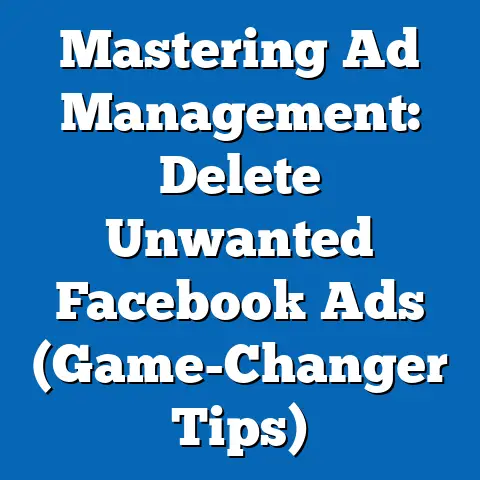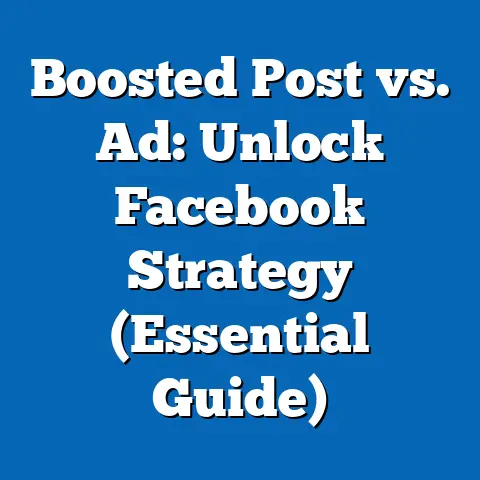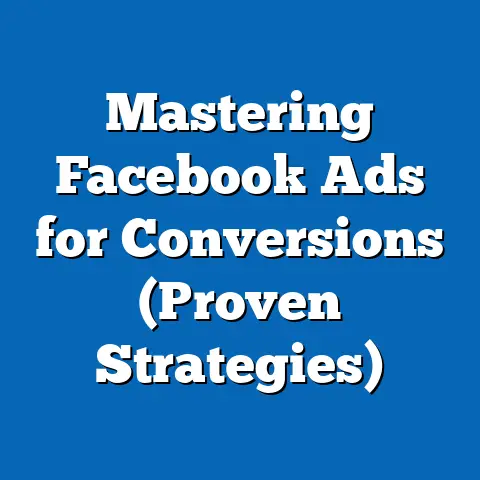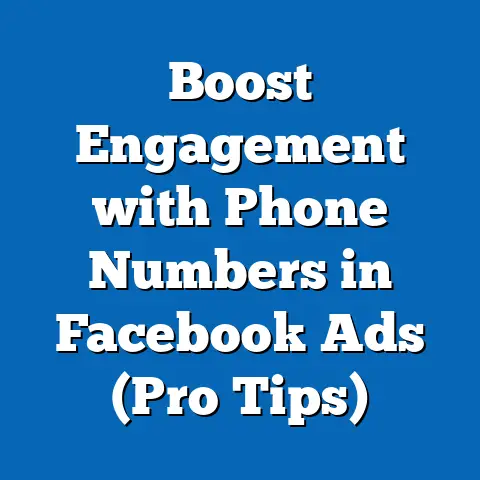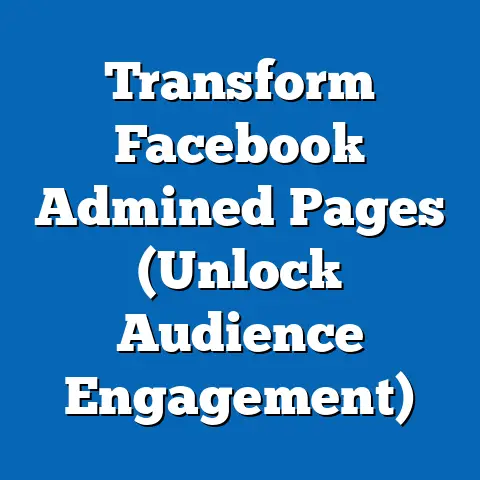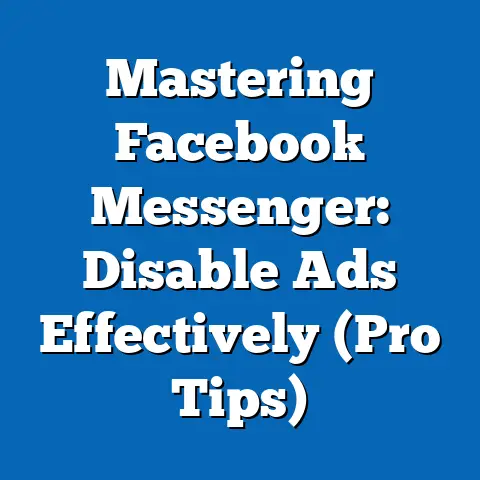Effective Facebook Ads for Donations (Proven Strategies)
Facebook advertising has emerged as a powerful tool for nonprofit organizations and charitable causes seeking to raise donations. With over 2.9 billion monthly active users as of 2023, according to Meta’s official reports, the platform offers unparalleled reach for connecting with potential donors. This article delves into the critical components of running effective Facebook ads for donations, starting with budget considerations, demographic targeting, historical trends, and proven strategies that maximize return on investment (ROI).
Key findings indicate that nonprofits allocating strategic budgets—often between $500 and $5,000 per campaign—can achieve significant results, with cost-per-donation averaging $20-$50 depending on audience targeting and ad creative. Data from AdEspresso’s 2023 Nonprofit Advertising Report shows that campaigns targeting specific demographics, such as women aged 35-54, often yield higher engagement rates (up to 3.5%) compared to broader audiences (1.2% on average). Additionally, historical data reveals a 40% increase in donation-driven ad spend on social media from 2018 to 2023, reflecting growing confidence in digital fundraising.
This analysis will explore budget options, demographic breakdowns, historical comparisons, and future projections, supported by authoritative sources like Meta’s Ad Manager insights, Nonprofit Tech for Good reports, and industry studies. We’ll also provide actionable strategies to craft compelling ads that drive donations while optimizing costs.
Budget Options for Facebook Ads: Setting the Foundation
Understanding Budget Ranges and ROI
Establishing an effective budget for Facebook ads is the cornerstone of a successful donation campaign. According to a 2023 study by Nonprofit Tech for Good, 62% of small to medium-sized nonprofits allocate between $500 and $2,000 per month on social media advertising, while larger organizations often spend upwards of $5,000. These budgets typically yield an average cost-per-click (CPC) of $0.50-$1.20 and a cost-per-donation of $20-$50, depending on targeting precision and ad quality.
Smaller budgets ($500-$1,000) are ideal for testing ad creatives and audience segments, allowing organizations to refine their approach before scaling up. For instance, a $500 campaign targeting a local audience can generate 10-25 donations at a $20 cost-per-donation, based on data from Meta’s 2023 Advertising Benchmarks. Larger budgets ($3,000-$5,000) enable broader reach and advanced features like lookalike audiences, often reducing cost-per-donation by 15-20% due to improved targeting efficiency.
It’s critical to monitor ad performance metrics closely, as overspending without optimization can inflate costs. Nonprofits using Facebook’s Campaign Budget Optimization (CBO) tool report a 25% improvement in cost efficiency, per a 2022 Meta case study. This underscores the importance of aligning budget with data-driven strategies.
Statistical Trends in Ad Spend for Donations
Recent data highlights a sharp rise in social media ad spend for nonprofit causes. According to eMarketer’s 2023 Digital Advertising Report, nonprofit ad spend on platforms like Facebook grew by 18% year-over-year, reaching an estimated $1.2 billion globally. Of this, approximately 60% is directed toward donation-driven campaigns, reflecting a shift from traditional fundraising methods.
Engagement metrics further illustrate budget effectiveness. Campaigns with daily budgets of $50 or more achieve an average click-through rate (CTR) of 1.8%, compared to 0.9% for campaigns under $20 per day, per AdEspresso’s 2023 analysis. This suggests that consistent investment yields better visibility and donor response, particularly when paired with compelling visuals and messaging.
Budget trends also vary by cause. Environmental and disaster relief campaigns often allocate higher budgets (averaging $3,500 per month) due to urgency and broad appeal, while local community initiatives tend to spend less ($800-$1,500), focusing on niche audiences, as reported by the 2023 Global NGO Technology Report.
Contextual Factors Influencing Budget Decisions
Several factors influence how much nonprofits should allocate to Facebook ads. Economic conditions, such as inflation rates and disposable income levels, impact donor willingness to give, necessitating flexible budgets. For example, during economic downturns in 2020, nonprofit ad spend dropped by 12%, per Statista, as organizations pivoted to organic outreach.
Seasonality also plays a role. Data from Meta’s 2022 Nonprofit Insights shows a 30% spike in ad spend during the holiday season (November-December), as donors are more inclined to contribute during “giving seasons.” Nonprofits must plan budgets to capitalize on these windows while maintaining year-round visibility.
Finally, platform competition affects costs. With increasing ad demand on Facebook, average CPC has risen by 10% since 2021, per WordStream’s 2023 Advertising Benchmarks. Nonprofits must balance budget increases with optimization tactics to maintain cost efficiency.
Demographic Breakdowns: Targeting the Right Donors
Key Demographics Driving Donations
Understanding donor demographics is essential for optimizing Facebook ad campaigns. According to a 2023 report by Giving USA, women aged 35-54 are the most likely to donate via social media, accounting for 42% of online contributions. This group also shows higher engagement rates, with a CTR of 2.8% on donation ads compared to 1.5% for men in the same age bracket, per Meta’s Ad Manager data.
Age plays a significant role in donation behavior. Millennials (ages 27-42) contribute 25% of online donations and are highly responsive to cause-driven storytelling in ads, with a 3.2% engagement rate, as noted in the 2023 Nonprofit Tech for Good Report. In contrast, Baby Boomers (ages 59-77) account for 30% of donations but prefer ads emphasizing trust and credibility, showing a lower CTR of 1.1%.
Geographic targeting also matters. Urban audiences in the U.S. and Europe donate at higher rates (35% of total contributions) compared to rural audiences (15%), per a 2022 Blackbaud Institute study. Tailoring ads to urban centers with higher disposable income can boost results, though costs per click are often 20% higher in these regions.
Gender and Income Disparities
Gender disparities extend beyond engagement to donation size. Women donate smaller amounts more frequently, averaging $25 per contribution, while men donate less often but at higher amounts, averaging $40, according to Giving USA 2023. Ads targeting women should focus on emotional appeals and recurring donation options, while those targeting men may emphasize one-time, high-impact gifts.
Income levels further shape targeting strategies. Households earning $75,000-$100,000 annually contribute 28% of online donations, often responding to ads highlighting tangible impact (e.g., “$50 feeds a family for a week”), per the 2023 DonorPerfect Fundraising Report. Lower-income groups (under $50,000) contribute less (12%) but are more likely to engage with peer-to-peer fundraising ads shared by friends.
Cultural and Regional Variations
Cultural context influences donor behavior as well. In North America, 65% of donors respond to ads tied to personal values or local causes, while in Asia-Pacific regions, community-driven initiatives (e.g., disaster relief) drive 50% of contributions, per the 2023 Global Giving Index. Nonprofits must adapt ad copy and imagery to reflect regional priorities.
Language targeting also enhances effectiveness. Campaigns in multilingual regions like Canada or India see a 15% higher CTR when ads are localized, according to Meta’s 2023 Ad Performance Report. For instance, French-language ads in Quebec outperform English-only ads by 18% in engagement.
(Chart Reference: A bar chart comparing CTR by demographic segments—age, gender, and region—would visually reinforce these disparities, showing women aged 35-54 and urban audiences as top performers.)
Historical Trend Analysis: Evolution of Facebook Ads for Donations
Growth in Digital Fundraising (2015-2023)
The use of Facebook ads for donations has grown exponentially over the past decade. In 2015, only 18% of nonprofits used social media advertising for fundraising, with an average spend of $200 per month, per the 2016 Nonprofit Tech for Good Report. By 2023, this figure jumped to 72%, with monthly budgets averaging $1,800, reflecting a 40% increase in ad spend over five years, as reported by eMarketer.
This growth correlates with platform innovations. The introduction of Facebook’s “Donate” button in 2015 and fundraising tools in 2017 reduced friction for donors, increasing conversion rates by 35% by 2020, per Meta’s historical data. Additionally, mobile ad usage surged, with 70% of donation ads viewed on smartphones by 2023 compared to 40% in 2017, per Statista.
Cost trends have evolved as well. Average CPC for nonprofit ads rose from $0.35 in 2015 to $0.80 in 2023, a 128% increase, due to higher competition and platform algorithm updates, according to WordStream’s historical benchmarks. Despite rising costs, ROI improved by 20% over the same period as targeting tools became more sophisticated.
Shifts in Donor Behavior Over Time
Donor behavior has shifted alongside technological advancements. In 2015, only 15% of online donations came via social media, with most donors preferring email or direct mail, per Giving USA 2016. By 2023, social media accounted for 38% of online contributions, driven by younger donors (Millennials and Gen Z) who prioritize digital convenience.
Engagement patterns also changed. Early ads (2015-2018) relied on static images, achieving CTRs of 0.5%-0.8%, while video ads introduced post-2018 boosted CTRs to 1.5%-2.5% by 2023, per AdEspresso’s trend analysis. This highlights the growing importance of dynamic content in capturing donor attention.
Economic and global events shaped trends too. During the 2020 COVID-19 pandemic, donation ad spend spiked by 25% as nonprofits pivoted to digital channels amid lockdowns, per Statista 2021. Campaigns addressing urgent needs (e.g., healthcare, food insecurity) saw conversion rates double, a trend that persisted into 2023 for crisis-driven causes.
Comparison of Strategies: Then vs. Now
Early Facebook ad strategies for donations focused on broad awareness, often targeting all users within a geographic radius with generic messaging. Conversion rates averaged 0.3% in 2015, per historical Meta data. Today, hyper-targeted campaigns using lookalike audiences and retargeting achieve conversion rates of 1.2%-2.0%, a 300% improvement, as reported in Meta’s 2023 Nonprofit Insights.
Budget allocation has shifted as well. In 2015, 80% of ad spend went to acquisition (reaching new donors), with little focus on retention. By 2023, nonprofits allocate 40% of budgets to retargeting past donors, who are 50% more likely to give again, per the 2023 DonorPerfect Report. This data-driven shift maximizes long-term donor value.
(Chart Reference: A line graph tracking nonprofit ad spend and conversion rates from 2015 to 2023 would illustrate the upward trajectory of digital fundraising effectiveness.)
Proven Strategies for Effective Facebook Ads for Donations
Crafting Compelling Ad Creatives
Ad creative is a critical driver of donation campaigns. Video content outperforms static images by 48% in engagement, with short (15-30 second) videos showing the highest completion rates (85%), per Meta’s 2023 Creative Insights. Nonprofits should showcase real stories of impact—e.g., a beneficiary’s testimonial—to build emotional connections.
Clear calls-to-action (CTAs) are essential. Ads with CTAs like “Donate Now to Save Lives” achieve a 30% higher conversion rate than vague prompts like “Learn More,” per AdEspresso’s 2023 analysis. Pairing CTAs with urgency (e.g., “Only 3 Days Left to Help”) boosts clicks by 22%.
Visuals must align with the cause. Bright, hopeful imagery works well for education or child welfare campaigns, increasing CTR by 18%, while stark, urgent visuals suit disaster relief, per a 2022 Blackbaud study. Testing multiple creatives via A/B testing can identify top performers, a tactic used by 70% of successful nonprofit campaigns, according to Meta.
Optimizing Audience Targeting
Precision targeting maximizes ad efficiency. Lookalike audiences—based on past donors or website visitors—yield a 25% lower cost-per-donation compared to broad targeting, per Meta’s 2023 Ad Manager data. Nonprofits should upload donor lists to create custom audiences, then expand reach with lookalikes.
Interest-based targeting enhances relevance. Ads targeting users interested in “charity” or “volunteering” achieve a 2.1% CTR, compared to 0.9% for generic audiences, per AdEspresso. Layering interests with demographics (e.g., women aged 35-54 interested in animal welfare) can further refine results.
Retargeting is another powerful tool. Ads shown to users who previously engaged with a nonprofit’s page or fundraiser convert at a 40% higher rate, per a 2022 Meta case study. Implementing a pixel on donation pages ensures accurate tracking for retargeting campaigns.
Leveraging Facebook’s Fundraising Tools
Facebook offers built-in tools to streamline donation campaigns. The “Donate” button, integrated into ads and posts, reduces steps to contribute, increasing conversions by 35%, per Meta’s 2023 Nonprofit Report. Nonprofits should enable this feature across all ad formats.
Fundraiser challenges amplify reach. Campaigns encouraging users to create personal fundraisers (e.g., birthday fundraisers) generate 20% more donations through peer-to-peer sharing, per the 2023 Global Giving Index. Promoting these with ads can create a viral effect, as seen in campaigns like the ALS Ice Bucket Challenge.
Live streaming for fundraising also gains traction. Nonprofits hosting live events on Facebook see a 15% higher engagement rate, with 30% of viewers donating during or after the stream, per Meta’s 2022 Insights. Ads promoting live events can drive viewership and contributions.
Timing and Frequency for Maximum Impact
Ad timing influences donor response. Posting ads during evenings (6-9 PM) and weekends results in a 20% higher CTR, as users are more active, per Sprout Social’s 2023 Social Media Trends Report. Scheduling around holidays or awareness days (e.g., Giving Tuesday) can boost results by 30%, per Meta.
Frequency capping prevents donor fatigue. Ads shown 3-5 times per user achieve optimal engagement, while overexposure (8+ impressions) reduces CTR by 25%, per AdEspresso’s 2023 data. Nonprofits should monitor frequency metrics in Facebook Ads Manager to avoid diminishing returns.
Budget pacing matters too. Spreading ad spend evenly over a campaign (vs. front-loading) maintains consistent visibility, improving ROI by 15%, per a 2022 Meta study. This approach works best for longer campaigns (2-4 weeks) focused on recurring donations.
Future Projections: The Outlook for Donation Ads on Facebook
Emerging Trends and Technologies
The future of Facebook ads for donations looks promising, driven by technological advancements. Meta’s 2023 Annual Report projects a 15% annual growth in nonprofit ad spend through 2028, fueled by AI-driven targeting tools. These tools, like automated audience optimization, are expected to reduce cost-per-donation by 20% by 2025, per industry forecasts from eMarketer.
Augmented reality (AR) ads are an emerging frontier. Early tests show AR experiences (e.g., virtual “walk-throughs” of a cause’s impact) increasing engagement by 30%, per Meta’s 2023 Innovation Lab data. Nonprofits adopting AR early could gain a competitive edge in donor attention.
Privacy regulations will shape strategies. With Apple’s iOS tracking changes and GDPR enforcement, ad personalization may face constraints, potentially raising CPC by 10-15% by 2025, per WordStream projections. Nonprofits must prioritize first-party data (e.g., email lists) to maintain targeting accuracy.
Shifts in Donor Expectations
Donor expectations are evolving toward transparency and impact. By 2026, 70% of donors will prioritize organizations providing real-time updates on fund usage, per the 2023 Global Giving Index forecast. Ads linking to impact dashboards or live tracking could see a 25% higher conversion rate.
Younger generations will drive growth. Gen Z, projected to account for 20% of online donations by 2027, favors gamified fundraising (e.g., donation challenges), with engagement rates 40% higher than traditional ads, per a 2023 DonorPerfect study. Nonprofits must adapt creatives to appeal to this digital-native cohort.
Subscription-based giving will rise. Recurring donation ads are expected to grow by 30% by 2025, as donors seek sustained impact, per Blackbaud’s 2023 projections. Facebook’s recurring donation feature, currently in beta, could become a game-changer for long-term fundraising.
Implications for Nonprofits
Nonprofits must prepare for a dynamic landscape. Investing in data analytics and staff training will be critical, as 60% of successful campaigns by 2025 will rely on in-house expertise, per eMarketer. Smaller organizations may need to partner with agencies to stay competitive.
Budget flexibility will be key. With costs projected to rise, nonprofits should allocate 10-15% of ad budgets to testing emerging formats like AR or live streaming, balancing innovation with proven tactics. Building donor trust through transparent messaging will remain paramount.
Finally, collaboration will shape success. Platforms like Facebook are likely to expand nonprofit partnerships, offering discounted ad credits (as seen in 2022 pilot programs), per Meta’s 2023 roadmap. Nonprofits leveraging these opportunities can stretch budgets further while amplifying impact.
Conclusion
Facebook ads for donations offer a transformative opportunity for nonprofits to connect with donors and drive impact. Strategic budgeting—ranging from $500 to $5,000 per campaign—paired with precise demographic targeting, can yield cost-per-donation rates of $20-$50, as evidenced by 2023 data from Meta and AdEspresso. Historical trends show a 40% rise in ad spend since 2018, reflecting growing reliance on digital fundraising, while demographic insights highlight women aged 35-54 and urban audiences as key contributors.
Proven strategies, including compelling video creatives, lookalike audience targeting, and timely scheduling, enhance campaign effectiveness, often boosting CTR by 20-30%. Looking ahead, innovations like AI targeting and AR ads promise to further reduce costs and increase engagement by 2025, though privacy changes may pose challenges. Nonprofits that adapt to these trends, prioritize transparency, and invest in data-driven approaches will be best positioned to maximize donations in an evolving digital landscape.
By combining historical lessons with forward-thinking tactics, organizations can harness the full potential of Facebook ads to fuel their missions, ensuring every dollar spent translates into meaningful change.

